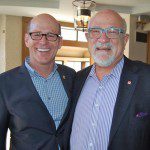Wollesen of the Clarice Touts Bringing Arts to Younger Audiences
By • March 26, 2015 0 1729

Outside, it looked as if the long, baleful tide of winter storms and stress seemed to have abated. If spring had not entirely sprung, the temperatures and the air, if not the pot holes, were entirely welcome.
It seemed that the presence of Martin Wollesen, the executive director of the Clarice Smith Performing Arts Center at the University of Maryland as the speaker of the Georgetown Media Group’s monthly Cultural Leadership Breakfast at the George Town Club, fit the new spirit of spring-like optimism and energy on March 12.
Wollesen, who came to Maryland in 2013 to head the Clarice after a provocative and exhilarating stint as the artistic director for ArtPower! at the University of California, San Diego, in attitude, spirit and energy, presented as nothing less than a cultural and performing arts pied piper, charging ahead into a changed arts ecology, dropping ideas like from flowers from a bouquet, some of which could also pass for bombshells.
The Clarice on the University of Maryland’s main campus in College Park, a place usually known for its embrace of its Terrapin football and basketball program especially with the approach of March Madness, is something of a hidden treasure for Washington arts enthusiasts, who tend not to venture too far afield from a city, rich with an abundance of big, medium-sized and small performance arts offerings.
Yet, the Clarice Smith Performing Arts Center should not be ignored, and neither should Wollesen, a nervy, intriguing spokesman not only for the Clarice, but for the arts in general. This is a man who’s lived a life rooted in diversity—born in Northern California, raised in Singapore and the Philippines, often in his youth running to the sounds of crisis in lands far away from our comfort zone. He lived in the Philippines when it was ruled by President Ferdinand Marcos, he lived on a kibbutz near trouble zone borders. “I wanted to go where bombings were happening,” he admitted. “But at the kibbutz, all I did was to end up painting toys for children. When you’re young, you think you’re invincible,” he told us.
That range of experience may account for his willingness to listen to, be more than tolerant of, and try out new ideas about the performance arts, how they’re presented, their audience and artists. “We’re living in a rapidly changing society, and the arts I think will have to change, too,” he said. “You can see it happening. There’s a whole new audience out there, and a whole new world of technology. We need to draw these tech-savvy audiences to us, and we need to come to them, too.”
Wollesen is all about collaboration, about recognizing the new arts environment and the likely audiences. He appeared to be delighted in the examples he unloaded from his diverse bouquet of ideas. “In San Diego, we had this young, very talented and well known string quartet, and there were a lot of students in the audience and they loved it and so after every movement they jumped up and applauded, which, in the world of classical music is a no-no, it just isn’t done. So some regular patrons were very upset, and suggested I tell people not to applaud. But I also talked to the artists, and they said, no, we loved what they did.”
Stressing that new audiences are linked to technology and that presenters should embrace the technology and understand it, Wollesen said, “When you see people texting or tweating, I know a lot of people find that annoying. But it’s part of the way today’s audiences receive performance art. I saw a program, a classical music program, where a young woman had her pad open throughout—she looked things up, the composer, the performers, the piece, and then she texted her friends about the performance.”
He’s about cooperation or bringing the art to the audiences: “We brought performers to the dorms, or the schools. It’s not every day you have that kind of thing in a dormitory.”
One of the ideas that he offered was the use of Twitter during the course of a performance in which audience response is measured and comments copied and then thrown on a giant screen during intermission.
“We’re used to being at a performance and being quiet,” he said. “The new audiences are not. They want to participate.”
At the Clarice, Wollesen has quite a playground to operate in. It includes the Cafritz Foundation Theatre (a black box space with 86 seats); a dance theatre, with 207 seats; the Dekelboum Concert Hall, with 970 seats and a 126-set choir loft; the Gildenhorn Recital Hall with 297 sets; the Kay Theatre with 626 seats and the Kogod Theatre with 156 seats. The Clarice is also the site of the DeVos Institute of Arts Management at the University of Maryland, headed by Michael Kaiser, the former president of the Kennedy Center.
Wolleson is an arts enthusiast, a futurist and an arts optimist. “I believe in new spaces and new work,” he said. “I think performance arts centers must connect with the community, to find new artists and bring new arts to the community.
- Martin Wollesen at the George Town Club March 12. | Robert Devaney
- Nora Birch





